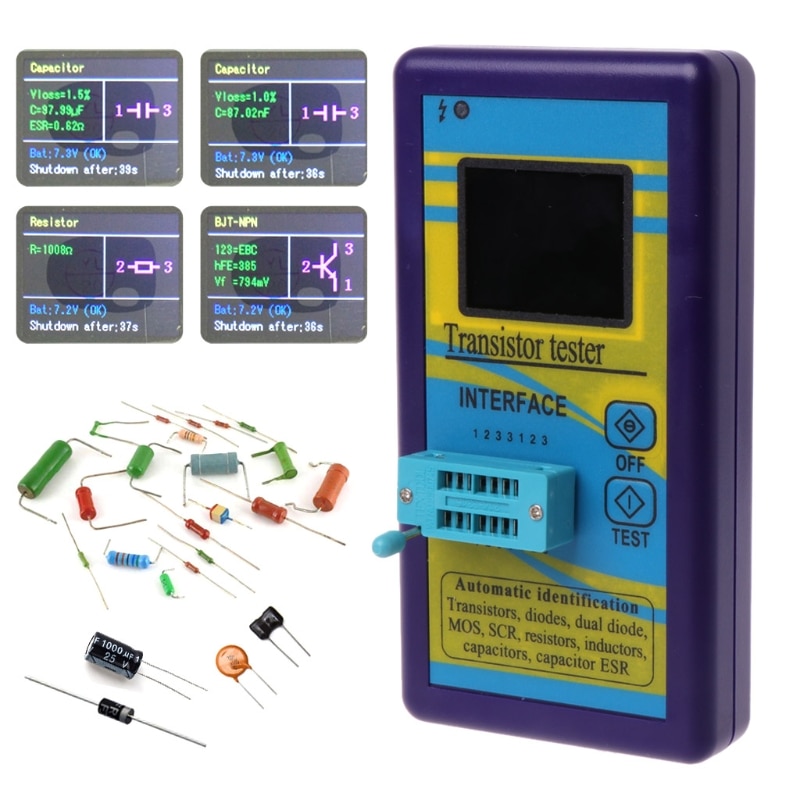There are two easy methods that we can use for diode anode cathode identification. The first one is by locating the gray bar on the body of the diode – that is the cathode terminal. The second method involves the use of an M328 component tester.
You will use the first method for most of the cases. The second method is just another alternative to make your life easy and bring a little fun to your lab.
Hi, I am Abbas. In the rest of the article, I will explain the above said methods in detail. In the end, you should be confident to identify the anode and cathode of any given diode including the LEDs
I am not perfect nor this article is going to be. This is just my limited knownledge try to help you somehow.
I hope you will enjoy it.
Diode Anode Cathode Identification
A diode is a two terminals semiconductor component. It allows current flow in only one direction.
For proper flow of current, the diode has to be in forward bias mode, i.e. its cathode terminal should be connected to the negative of the voltage source and the anode should be attached to the positive terminal of the voltage source.
But the question is, how to know which terminal is an anode and which terminal is the cathode, so we can properly bias it for our circuits.
Let’s find out below.
Method 1: Visual inspection
This method is the most used method. You will also use it a lot of times.
In this method we just simply take the diode which we want to know the right terminal and follow the following steps:
- Take the diode
- Look for a gray line bar on the body of the diode

- Once you identify the bar.
- Mark the terminal on which you identify the bar.
- This terminal is negative cathode.
- The other one is the positive anode – It is that simple
This method fails if you have a diode with no bar on it, i.e. its bar has been removed with time.
Let’s see the steps for the LED diode anode cathode identification.
LED is short for light emitting diode. It is basically a type of diode that we use for indication purposes in almost every electronics product and device.
LEDs come in various sizes and colors. To properly work with them, you have to connect them in forward bias mode, else they will not glow and in some worst cases you may end up blowing your LEDs.
Follow the following steps to identify the terminals of any LED.
- Take your LED
- Identify the long terminal between the two given legs.

- This long leg is your positive anode
- The shorter one is the negative cathode – it is just that easy to identify.
Now this method fails if you have an old used LED, whose legs length are the same. Or it is hard to tell which terminal is shorter than the other.
In such cases follow the following steps.
- Take your LED
- Look for a cut side (you will definitely see a small cut side in any LED)
- This cut side is your positive anode
- The other terminal is automatically your negative cathode.
The above methods are used for every LED. It doesn’t matter which size or shape the LED has – these steps should be followed to exactly identify the right pin terminals.
There are of course other types of diodes as well for example the Zenor diode.
Follow the following steps for Zenor diode terminals:
- Take the zenor diode
- Identify the black thin bar line on its body.
- That black line bar terminal is the negative cathode
- The other terminal is your positive anode.
Now it is practically known that to know the cathode of any type of diode – look for a bar. The color of the bar can be any just identify it. This is your cathode and the other terminal will be by default your positive anode.
The above general method of looking for a bar is also applicable to SMD diodes as well.
SMD diodes are tiny devices but if you look carefully at them, you should definitely see a bar. This bar is your cathode.
This is also true of SMD LEDs as well.
The only limitation of this method is if your bar has been removed with time – then you can’t follow this method. Then you should be looking at other related methods.
Method 2: By Using M328 Tester
In my opinion, you will be using the above methods throughout the rest of your electronics work life.
Because they are easy and straight forward.
But I also think that life is about learning new things, life is about having new experiences.
So, that is why I am including this method. This can be your new life experience. And you can also add the M328 to your lab equipment collection.
Alright!
M328 Component tester is a device that helps us:
- Identify various electronics components
- It helps to test if the component is good or bad
- It helps us to identify the pin configuration of various electronics components including diodes and transistors of any type
- It also gives us the circuit diagram of the testing components and all the related parameter values in a matter of seconds.
So how we can use M328 for the diode anode cathode identification? Well, it is very easy.

Follow the following steps, and you are good to go.
- Take the M328 Tester
- Take your diode that you want to test for the right pins
- Place the diode in the component tester
- Press the test button.
- Get the results on the display.
- The results will be in the form of a circuit diagram with the right pin configuration. – it is that simple.
The benefit of this method is you can check the pins of any diode. You can test a diode even if its bar has been completely removed with time or for whatever reason.
I like M328 Component Tester (Amazon link) for various reasons. It is fun when you put a component, press test, and see all the related information right there on a single screen. If you like it too, get yourself one.
Conclusion
A diode is a two terminals passive component. To work properly with it, you have to identify it right pin configuration just like any other electronic component.
By right pin configuration, I mean which terminal is the anode (positive terminal) and which one is the negative cathode.
In this article, we try to look at some methods for diode anode cathode identification.
The first method is a visual inspection. In this method, we look for the gray bar on the body of any diode. Once we find it – that is our negative cathode. The other one is the positive anode.
The second method requires an M328 component tester. In this method, we just put our diode in the M328 tester, press the test button, and get the exact results in no time.
There you have it guys.
I hope you enjoyed this article.
The following are helpful resources to learn more about diodes.
- Easy diode reading for beginners (Pin, Bridge, Zenor)
- Diode Testing (Know if a diode is bad, open, or short)
- 13 Diode Functions in Circuit (Key Roles of Diode)
- Bad Diode Symptoms (How to know if a diode is bad)
- Identify terminals of unmarked diodes (Easy Solution)
- How To Test Diode Without Multimeter (Easy Solutions)
- Learn Diode Basics for complete beginners (Easy guide)
- Design of Half Wave Rectifier Circuit [Single Phase]
Free resources for someone just getting started with electronics.
- Basic electronics for beginners (Easy step by step)
- 21 Best electronics tools & equipment for beginners
- 15 Best Electronics Component Kits For Beginners
- Get Started with Electronics (Step by Step Guide)
Thank you and have a grateful life.
